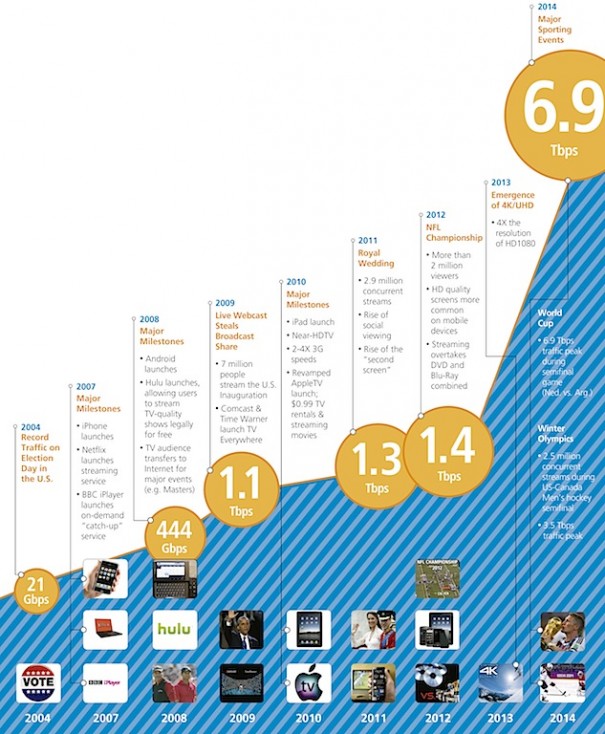La evolución del vídeo online y cómo los broadcasters adoptan nuevas estrategias
Coincidiendo con el último Mundial de Fútbol, el streaming online alcanzó nuevos máximos con las tasas de tráfico pico rompiendo récords. Lo que se ha hecho patente es que las audiencias acceden al contenido en streaming para complementar su experiencia de visualización de deportes, programas televisivos preferidos o películas y ahora utilizan cada vez más esta tecnología como primer mecanismo de entrega. ¿Qué ha provocado este cambio en el comportamiento de los espectadores y cómo los broadcasters están adoptando con éxito estrategias de vídeo online?
En 2014, el Mundial de Brasil marcó un nuevo e impresionante máximo para el vídeo online con una tasa de tráfico pico de 6,9Tbps registrada en la Plataforma Inteligente de Akamai durante el partido de semifinal entre Holanda y Argentina el 9 de julio. Para poner las cosas en contexto, 6,9Tbps equivale a 6.900.000.000.000 bits de información por segundo. Lo más importante es que el pico de audiencia online para algunos partidos superó con creces los 5 millones de espectadores.
Akamai trabajó con más de 50 broadcasters y entregó los streams en directo a más de 80 países en todo el mundo, haciendo que este torneo fuera el acontecimiento deportivo en directo más grande nunca entregado sobre nuestra plataforma. Pero esperamos que la demanda crezca todavía más en el futuro.
El vídeo online ya no se considera como nicho y ha salido del espacio de los usuarios pioneros. Ahora, retando la tecnología de broadcast tradicional, el streaming de vídeo de alta calidad en directo se ha vuelto corriente y el ritmo de este cambio ha sido rápido.
A finales del Milenio
En 1999, la marca de lencería Victoria’s Secret celebró su desfile de moda anual online. Para promocionar el evento, gastó 1,5 millones de dólares en publicidad durante la Super Bowl y $4 millones en medios impresos. Consiguió su objetivo de llamar la atención, pero para muchos espectadores que intentaron ver el webcast, fue una decepción cuando el sitio web cayó y para aquellos que pudieron establecer contacto, la visualización se estropeó por un audio y vídeo pobres. El volumen de tráfico alcanzado fue de 1 Gigabit por segundo (Gbps).
Como era de esperar, Steve Jobs de Apple era un verdadero usuario pionero, estableciendo records de webcast de sus presentaciones en la MacWorld Expo anual a finales de los años 90.
En 2001, el webcast ‘stevenote’ estableció records en Internet para los medios de streaming en la web con 250.00 personas que vieron varias partes de su presentación y más de 35.500 espectadores generando 5,3 Gbps de tráfico de streaming pico. En aquel momento, esto equivalía al tamaño de la audiencia típica de un programa televisivo por cable. El webcast de 2001 empleaba MPEG1, pero al año siguiente Apple volvió a romper récords alojando el primer evento de streaming importante utilizando MPEG-4 que se convirtió rápidamente en el estándar para entregar audio y vídeo de alta calidad.
El día de las elecciones norteamericanas en 2004 estableció un nuevo máximo de pico de tráfico de 21Gbps en la plataforma de Akamai, pero en 2007 el streaming ya iba siendo más común y el foco se centraba mucho más en la entrega de una experiencia de calidad. La introducción del BBC iPlayer y el lanzamiento de Netflix para responder a la demanda de los consumidores fueron en parte viables gracias a que la calidad del streaming online mejorara ampliamente gracias a HVGA que entrega una experiencia broadcast ‘casi SDTV’.
La alta calidad consigue audiencias masivas
En 2008 el número de televidentes tradicionales que hacían streaming de contenido desde Internet era mayor, accediendo a programas, películas y acontecimientos deportivos en sus PCs y laptops, con un compromiso medio que duraba 17 minutos. Ofrecer contenido online se estaba convirtiendo rápidamente en una prioridad para los broadcasters.
Entre 2008 y 2011 los cambios simultáneos e impactantes tanto en la tecnología de los dispositivos como en los estándares de entrega generaron audiencias online cada vez mayores. SD fue sustituido por HD y MPEG-4 se convirtió en el estándar para el streaming. Los teléfonos Android fueron anunciados en 2008 y seguidos rápidamente por las tabletas, destacándose el Apple iPad en 2010, ofreciendo una calidad ‘casi-HDTV’ a una velocidad de 2-4x3G. Estos cambios generaron una mayor demanda de streaming, y plantearon retos a los broadcasters que tuvieron que encontrar una manera de entregar a un número creciente de dispositivos.
Cuando se casaron el Príncipe William y Catherine Middleton en 2011 se generaron 2,9 millones streams simultáneos y 1,3Tbps en la Plataforma Inteligente de Akamai, pero esto se volvió insignificante si se compara con los Juegos Olímpicos de Sochi, que alcanzaron los 3,5Tbps durante una semifinal de hockey masculino, una tasa cuatro veces mayor que durante la carrera de 100m de Usain Bolt en los Juegos Olímpicos de verano de Londres en 2012. El tráfico total entregado por Akamai para los Juegos Olímpicos de Invierno en 2014 fue un 70 % mayor que el de Londres 2012. Pero en tan solo seis meses, la tasa de tráfico pico se duplicó con el Mundial de Brasil.
Tendencias futuras
A medida que crecen la audiencia online y las expectativas de los consumidores en cuanto a calidad, necesitamos pensar en la capacidad de las actuales tecnologías de streaming en Internet para entregar contenido 4k a escala, de forma económica a miles de millones de consumidores. Para poner esto en perspectiva, la Plataforma Inteligente de Akamai entrega ahora más de 25Tbps de tráfico diario a nivel global mediante cientos de miles de servidores embebidos en redes de ISP en más de 100 países.
En 2015 esperamos que esta cifra se duplique tal y como lo ha hecho año tras año durante los últimos 15 años pero estas cifras se vuelven insignificantes si se comparan con lo que nos depara el futuro – un futuro en el que se entregaran miles de Tbps de contenido en vídeo a miles de millones de espectadores a nivel global en miles de millones de dispositivos. L
a pregunta es si las actuales prácticas de entrega serán capaces de escalar, de forma económica y con la calidad que los consumidores esperan. Pues bien, la respuesta es que probablemente no en base a las actuales metodologías. En conjunto, tenemos que desarrollar nuevas maneras y tecnologías para hacer frente a las demandas del futuro.
Ninguna tecnología individual por sí sola puede resolver todos los retos pero como industria podemos desarrollar tecnologías para trabajar juntas y esto nos ofrecerá un futuro muy brillante para la entrega de vídeo online. Las oportunidades son nuestras y hay que aprovecharlas.
Ian Munford
Director de Marketing de Producto para la Región EMEA de Akamai
Did you like this article?
Subscribe to our NEWSLETTER and you won't miss a thing.

















